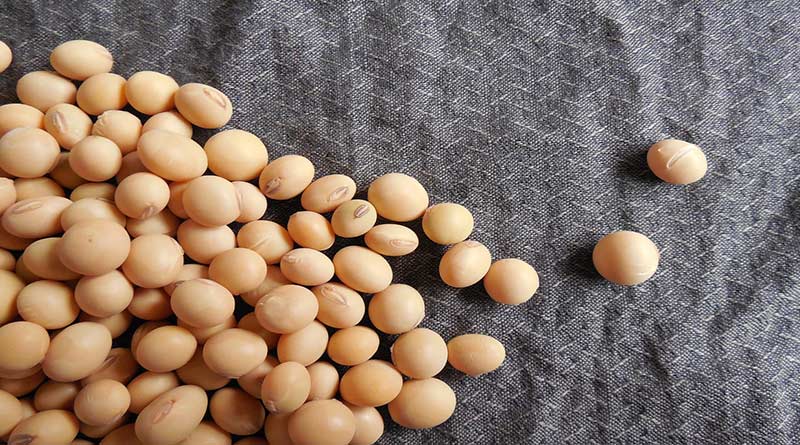More Brazilian supply weighs on Chinese soybean market
19 April 2023, China: The downward trend in the soybean market is unlikely to reverse anytime soon, according to crushers, and they are hence holding off on their purchases, which is further weighing on soybean prices.
Brazil is expected to produce 154mn t of soybeans in 2022-23, based on the latest estimates from the US Department of Agriculture (USDA) and Brazil’s national agricultural agency Conab. Combined with an estimated bumper corn crop this season, total oilseed and grain production in Brazil is expected to far exceed the country’s storage limit of about 191mn t, according to market sources.
Exporters and local farmers have consequently reduced soybean offers to attract more sales, in a bid to clear the glut of inventories and to free up more storage for the arrival of new-crop corn in late June-July.
Argus-assessed China-bound soybean prices for June-loading from Brazil fell to a multi-year low of a discount of ¢33.5/bu cfr to the July Chicago Board of Trade (CBOT) soybean futures contract on 19 April, down from the cfr premium of ¢107.5/bu a month ago for the same shipment period. The prices fell in line with a downward trend in the paper market, which also plunged by ¢140/bu over the same period for June settlement.
The lower prices lured some crushers back to the market, with several May-June loading deals reported over the past few weeks. But overall Chinese demand remained slower than expected, with total commitments for May shipment just surpassing 9mn t this week, according to market sources, with only 10 days left before loading starts in the month. Commitments for June shipment total 3.2mn-3.5mn t so far, with demand expected at 8mn t for the month.
Possible price reductions by farmers
Farmers’ selling paces in Brazil also lagged behind average historic levels. This was on top of delays in harvesting, and a strengthening of the Brazilian real against the US dollar. Current farm sales have reached 47-50pc of total crops, lower by 13-17pc from the pace in previous years. This means that 77mn-82mn t of soybean supplies have not been committed, adding further pressure on future soybean prices.
Soybeans were priced at R130/bag ($26/bag), or R62/bu, earlier this week in the domestic market. After deducting production costs of R33/bu, which includes fertilizers and pesticides, farmers’ soybean planting profit stood at around R26/bu ($5.20/bu). In comparison, outright soybean prices closed at $13.77/bu for June settlement in the paper market on 18 April. This suggests a higher likelihood for exporters and farmers to reduce their prices, considering accelerated soybean harvests and tightening storage limits in the country.
Soybean sellers may ramp up deals for shipments before mid-June, to avoid port loading congestion with new-crop corn. The offer prices on a cfr basis have continued to decline since last week, dropping below the breakeven point for the first time over the past few years for near-curve shipments.
For soybeans to be loaded after July, the price drops are likely to be limited, traders said, as Brazil was the largest supplier in the world from July-September. Yet-to-arrive US new-crop soy and a drought-induced Argentinian supply shortage will support soybean prices for the shipment period, allowing for the price losses resulting from record harvests and tighter storage limits to be partially recouped.
Slower Chinese demand pressures soybean prices
Soybean prices could also see pressure from slower-than-expected demand from China — the world’s largest importer — despite the country’s recovering board crush margins recently. For May loading from Brazil, Chinese soybean board crush margins jumped to negative -33 yuan/t (-$4.80/t) on 13 April, the highest level since November 2021, based on Argus assessments. But different trading and operating costs at major processors could pull overall soybean processing profits even lower. This has made crushers cautious about purchasing soybean from the global market.
Additionally, the slowdown in domestic forward soymeal sales has also discouraged soybean trade flows from the global market.
The pig market in China has yet to recover, with negative breeding profits weighing on feed producers’ buying demand. Downstream users have opted to secure just the necessary amounts to meet their operating needs, anticipating soymeal prices will fall in the near future with large-scale Brazilian soybean arrivals in mid-April.
China’s Ministry of Agriculture and Rural Affairs (Mara) recently announced a plan to cut soymeal usage in the animal feed sector, as a step towards reducing soybean imports from the global market.
The share of soymeal in feed rations is proposed to be reduced from 14.5pc in 2022 to lower than 13pc by 2025, reflecting a reduction of 6.8mn t in soymeal demand three years from now, based on Mara’s feed consumption estimate of 454mn t in 2022. Feed manufacturers are encouraged to turn to other protein supplies such as food waste and amino acids as substitutions.
If the scheme is implemented, China’s soybean demand could fall in the long term.
The overwhelming amount of Brazilian soybean supplies and slower-than-expected Chinese demand are also likely to raise Brazilian soybean ending stocks in 2022-23. The USDA projected Brazil’s 2022-23 soybean ending stocks at 32.75mn t in April — the third-highest in the past decade, just below 33mn t in 2017-18 and 33.3mn t in 2018-19. This reflected higher soybean stocks brought over after the tail-end of Brazil’s major export window of February-September, eroding the market share of US soybeans in the 2023-24 marketing year.
(For Latest Agriculture News & Updates, follow Krishak Jagat on Google News)















